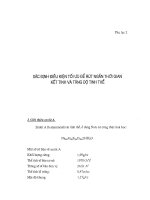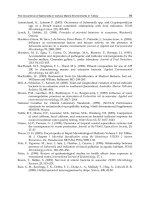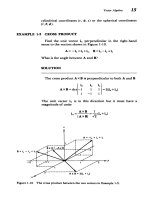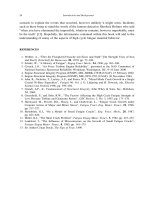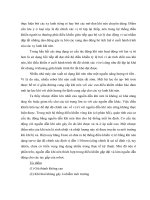McGraw-Hill Build a Remote Controlled Robot Part 5 doc
Bạn đang xem bản rút gọn của tài liệu. Xem và tải ngay bản đầy đủ của tài liệu tại đây (179.23 KB, 15 trang )
28 CHAPTER TWO
FIGURE 2-21. Drilling and cutting guide.
FIGURE 2-22. Drilling and cutting guide.
BODY FRAMEWORK 29
aluminum section, first write the correct number or letter on a
piece of masking tape and then apply the tape to its proper
location according to the figure of that piece.
After all the pieces have been prepared they must again be
separated into two groups—one group of pieces for each of
the two sections of Questor’s framework. The first group,
when assembled, forms the robot’s upper framework. The
pieces needed are as follows: four 36-inch- and six 10-inch-
long pieces.
The second group forms the lower section of the frame-
work and the pieces needed are: ten 20-inch and four 6-inch
pieces. Of the ten 20-inch pieces for the lower section of the
robot, only eight are needed. The remaining two are used as
connecting pieces between the lower and upper framework.
These two pieces can be identified by the letters A and B
which you should have marked on them.
FIGURE 2-23. Drilling and cutting guide.
Now that you have the pieces regrouped, study them and
familiarize yourself with these markings. How each section is
assembled will become obvious as you study the pieces. The
key to the assembly is the markings that allow all the
predrilled holes to line up correctly.
ASSEMBLING FRAMEWORK
Assembling the framework now becomes a simple matter of
matching the ends of the pieces according to the numbers on
their ends; and then riveting the matched ends together. Tables
2-2 and 2-3 list the numbered ends used in the matching
sequence for each of the two sections of the robot’s framework.
Table 2-2 is for the upper section and Table 2-3 is for the lower
section.
FIGURE 2-24. Drilling and cutting guide.
BODY FRAMEWORK 31
After you have matched the pieces, line up the predrilled
1/8-inch holes at the ends of each piece. If the holes on the
pieces do not line up (which happened to me three-quarters of
the time), clamp them together and redrill the 1/8-inch-diameter
hole in both pieces at the same time. Next insert a 1/8-inch rivet
into the hole and using a rivet gun “pop” the rivet to secure the
pieces. The rivet gun you use should come with directions.
Once you have completed both the upper and lower sec-
tions of the framework, they must be joined together with two
20-inch connection pieces marked A and B. To begin take the
lower section and place it so the two Fs (which stand for
front) on the front of this section face you. Then place the upper
section within the lower, with its Fs facing you. Figure 2-27
shows where the two connecting pieces are placed; the piece
marked A is placed at the front and the piece marked B in the
rear. The pieces are held in place by four 1-inch ϫ 1/4-inch-
FIGURE 2-25. Drilling and cutting guide.
32 CHAPTER TWO
FIGURE 2-26. Drilling and cutting guide.
TABLE 2-2. Matching List for Upper Framework
CORNERS UPPER FRAMEWORK MATCH AND RIVET ENDS NUMBERED
1 1-9-8-16
2 2-10-3-11
3 4-12-5-13
4 6-14-7-15
5 24-26
6 23-25
7 19-27
8 20-28
NOTE: Ends numbered 17, 18, 21, 22 are not riveted.
BODY FRAMEWORK 33
TABLE 2-3. Matching List for Lower Framework
CORNERS
LOWER FRAMEWORK MATCH AND RIVET ENDS NUMBERED
1 1-17-8-31
2 2-19-3-21
3 4-23-5-25
4 6-27-7-29
5 9-18-16-32
6 10-20-11-22
7 12-24-13-26
8 14-28-15-30
FIGURE 2-27. Location of connecting pieces.
34 CHAPTER TWO
diameter bolt, nut, and lockwasher sets. The upper and lower
body are now joined to complete Questor’s framework.
MOUNTING FRAMEWORK ON THE
PLATFORM
The next step in completing Questor’s body is mounting the
framework on the mobile platform. If you have chosen to
include the vacuum cleaner option in your version of Questor,
now is the time when it is installed.
Begin by placing the mobile platform on the floor so that the
castor wheel faces you, this is the front of the platform. Next
assemble the vacuum cleaner according to the instructions
included in the kit. Place the vacuum lengthwise on the plat-
form so that the vacuum’s motor faces the rear of the platform
and the hose outlet faces front. Make sure that the vacuum’s
mounting bracket sits flush with the platform. Once you have
the vacuum cleaner positioned correctly on the platform, lower
the framework onto the platform so that the Fs on the frame-
work face the front of the platform. The vacuum cleaner should
fit into the lower section of the framework as it is lowered onto
the platform. You will have to move the vacuum about with the
lower framework to accomplish this. Figure 2-28 shows how to
position the vacuum inside the framework.
Now that you have the vacuum and framework positioned
correctly on the platform, the mounting holes for each must
be marked and drilled. Begin by carefully marking the two
1/4-inch-diameter holes needed to secure the vacuum cleaner
unit. The bolts for this should be included in the vacuum
cleaner kit. Next mark the eight 5/32-inch-diameter holes
along the lower edge of the framework used to secure the
framework to the platform. You will use eight 1-inch ϫ 5/32-
inch-diameter bolt, nut, and lockwasher sets to secure the
framework in place. Now remove the vacuum and framework
and drill the holes. Replace the framework with the vacuum
cleaner inside, and bolt both in place. Press the bolts with
washers in place through the bottom of the platform, then
BODY FRAMEWORK 35
FIGURE 2-28. Vacuum position in lower framework.
bolt the parts in place. Be sure to place lockwashers on the
bolt before the nut is tightened. Figure 2-29 shows how the
framework is bolted to the platform.
MOUNTING THE VACUUM OUTLET
The final step for completing the mounting procedure is to
attach the vacuum cleaner outlet to the framework; this outlet
consists of a hinged door and switch assembly. When the door
is opened, the vacuum activates. To use the vacuum you open
the door and attach a white vacuum hose to the outlet.
The outlet is held to the framework by a bracket, shown in
Fig. 2-30, made from leftover aluminum angle. The outlet is
36 CHAPTER TWO
FIGURE 2-29. Bolt attaching framework to platform.
FIGURE 2-30. Vacuum outlet bracket.
BODY FRAMEWORK 37
then screwed to the bracket and the whole assembly bolted to
the lower front section of Questor’s framework utilizing two
1/4-inch predrilled holes at that location. Figure 2-31 shows
where and how the outlet assembly is mounted. Now that
both the vacuum and outlet are mounted, they must be joined
by a short section of black hose included in your vacuum kit.
Cut a piece of hose approximately 3 inches long. To connect
the vacuum to the outlet, unscrew the outlet from the bracket,
then connect the hose to the vacuum. Next connect the outlet
to the other end of the hose and screw it back to the bracket.
The mounting procedure just described is also used to change
the vacuum cleaner’s bags, so it is important that you under-
stand this assembly. Questor’s framework is not yet complete.
FIGURE 2-31. Mounted outlet.
This page intentionally left blank.
POWER SUPPLY AND
TEMPORARY
CONTROL BOX
Q
uestor’s systems get their power from a 12-volt battery
system. This system is comprised of two 6-volt batteries.
You will find as I did that most of the motors, lights, and some
electronics for robots require a 12-volt system; the temporary
control box is just that. Controls in the box switch the two
motorized wheels on Questor’s platform to on/off and reverse
thus controlling his direction. There are also two speed con-
trols mounted in the box, one for each wheel. The control box
is connected to the robot’s platform by a cable of wire; the
length is up to you. When wiring these systems make sure you
pay close attention to the wiring diagrams.
MOUNTING BATTERIES AND
BARRIER STRIPS
Questor gets his power from two 6-volt, gel-type batteries
mounted within his lower framework. The batteries are
mounted on the right and left sides of the upper framework
where it sits within the lower framework. Figure 3-1 shows
where one of these batteries is located.
Each of the two batteries is held in place by three 2-inch-
long pieces of aluminum angle. (Use the aluminum angle left
over from the building of the framework.) Two of these pieces
39
CHAPTER
THREE
Copyright 2002 The McGraw-Hill Companies, Inc. Click Here for Terms of Use.
40 CHAPTER THREE
FIGURE 3-1. Location of one of the two 6-volt batteries.
FIGURE 3-2. Battery mounting bracket.
POWER SUPPLY AND TEMPORARY CONTROL BOX 41
are bolted to the mobile platform, while the third is bolted to
the framework itself using a predrilled hole on the framework.
Figure 3-2 shows where to drill holes in each of the 2-inch
aluminum pieces.
To begin installing the batteries, first take two of the 2-inch
pieces of aluminum angle and bolt one to each side of frame-
work connecting piece B using two 5/32-inch bolt, nut, and
lockwasher sets for each. There are two predrilled holes on
each side of the upper framework. Next slide one of the batter-
ies under each of the pieces making sure that the battery ter-
minals face the front of the platform and that they are sitting
in their correct mounting positions. Then place two more alu-
minum pieces, with their mounting holes flush with the robot’s
platform, snug against the battery. Place one piece against the
front of the battery and one against the side; do this to both
batteries.
Mark the mounting holes on the platform where each of
the four aluminum pieces sit. Remove the pieces and battery
and drill the four 5/32-inch-diameter holes in the platform
TABLE 3-1. Parts List
AMOUNT
ITEM
2 6-volt, solid-gel battery, with charger kit
2 DPDT switch
1 SPST switch
1 Project box
1 or more Roll red 18-gauge wire
1 or more Roll black 18-gauge wire
2 2-post barrier strip and mounting screws
1 8-post barrier strip and mounting screws
2 25-watt, 10-ohm potentiometer
6 2-inch piece of leftover aluminum angle
6 1-inch ϫ 5/32-inch-diameter bolt, nut, and lockwasher set
1 Crimp kit
4 Small electrical twist caps
where marked. Once the holes are drilled, replace the batter-
ies with terminals facing the rear, and bolt the four 2-inch alu-
minum pieces in place, using four 1-inch ϫ 5/32-inch-diame-
ter bolt, nut, and lockwasher sets. Figure 3-3 shows the
mounting brackets in place. Now you could turn the robot
upside down and the batteries will remain in place.
The next step in providing Questor with power is to mount
multipost barrier strips at various points on the robot’s plat-
form. Figure 3-4 shows what one of these strips looks like.
These barrier strips are very important because they allow the
42 CHAPTER THREE
FIGURE 3-3. Mounting brackets in place.


